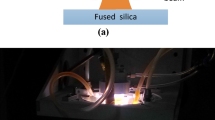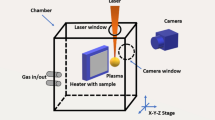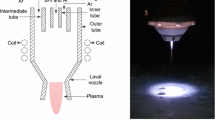Abstract
The use of fused silica material is crucial in various scientific applications; however, its chemical inertness and brittle nature pose challenges to machining and fabrication processes. The present study introduced a dynamic plasma flow system for medium-pressure plasma processing of fused silica substrate to address this issue. The results indicate that the new plasma flow system can significantly enhance the material removal rate compared to existing systems, with a 300% increase in material removal rate. Importantly, this process enables a sustained linear material removal rate, essential for long process durations. Despite the higher material removal rate, there is no deterioration in surface finish observed, and in fact, an improvement in surface integrity is noted after plasma processing. Confocal Raman microscopy characterization further confirms this improvement, revealing reduced stress-induced defect peaks compared to a confined plasma system.












Similar content being viewed by others
Data Availability
Not applicable.
References
Komanduri R, Lucca DA, Tani Y (1997) Technological advances in fine abrasive processes. CIRP Ann Manuf Technol 46:545–596. https://doi.org/10.1016/S0007-8506(07)60880-4
Namba Y, Ohnishi N, Yoshida S et al (2004) Ultra-precision float polishing of calcium fluoride single crystals for deep ultra violet applications. CIRP Ann 53:459–462. https://doi.org/10.1016/S0007-8506(07)60739-2
Kanaoka M, Liu C, Nomura K et al (2008) Processing efficiency of elastic emission machining for low-thermal-expansion material. Surf Interface Anal 40:1002–1006. https://doi.org/10.1002/sia.2818
Kanaoka M, Liu C, Nomura K et al (2007) Figuring and smoothing capabilities of elastic emission machining for low-thermal-expansion glass optics. J Vac Sci Technol B Microelectron Nanom Struct 25:2110. https://doi.org/10.1116/1.2789440
Kanaoka M, Takino H, Nomura K et al (2007) Removal properties of low-thermal-expansion materials with rotating-sphere elastic emission machining. Sci Technol Adv Mater 8:170–172. https://doi.org/10.1016/j.stam.2006.12.003
Yamamuraa K, Mimurab H, Yamauchib K, et al (2002) Aspheric surface fabrication in nm-level accuracy by numerically controlled plasma chemical vaporization machining (CVM) and elastic emission machining (EEM). 4782:265–270
Yamamura K, Shimada S, Mori Y (2008) Damage-free improvement of thickness uniformity of quartz crystal wafer by plasma chemical vaporization machining. CIRP Ann 57:567–570. https://doi.org/10.1016/j.cirp.2008.03.132
Kazemi F, Arnold T, Lorenz P et al (2020) Residual layer removal of technical glass resulting from reactive atmospheric plasma jet etching by pulsed laser irradiation. Plasma Chem Plasma Process 40:1241–1251. https://doi.org/10.1007/s11090-020-10101-2
Shi B, Dai Y, **e X et al (2016) Arc-enhanced plasma machining technology for high efficiency machining of silicon carbide. Plasma Chem Plasma Process 36:891–900. https://doi.org/10.1007/s11090-016-9695-4
Juškevičius K, Buzelis R, Samuilovas R et al (2016) Plasma etching of fused silica substrates for manufacturing high laser damage resistance optical interference coatings. Opt InfoBase Conf Pap 7:264–272. https://doi.org/10.1364/oic.2016.wd.9
Dev DSD, Krishna E, Das M (2016) A novel plasma-assisted atomistic surface finishing on freeform surfaces of fused silica. Int J Precis Technol. https://doi.org/10.1504/IJPTECH.2016.079998
Singh Yadav HN, Krishna E, Kombath S et al (2023) Investigation of MRR and surface characterization using plasma process. Mater Manuf Process. https://doi.org/10.1080/10426914.2023.2176873
Dev DSD, Krishna E, Das M (2018) Novel finishing process development for precision complex-shaped hemispherical shell by bulk plasma processing. In: Precision product-process design and optimization. pp 313–335
Hernandez-Rueda J, Clarijs J, Van Oosten D, Krol DM (2017) The influence of femtosecond laser wavelength on waveguide fabrication inside fused silica. Appl Phys Lett. https://doi.org/10.1063/1.4981124
Steven LS, Hsinchu T (2000) in-situ and non-intrusive method formonitorng plasma etch chamber condition utilizing spectroscopictechnique. U S Pat 1 to 3
Galeener FL, Geissberger AE (1983) Vibrational dynamics in Si-substituted vitreous Sio2. Phys Rev B 27:6199–6204
Liu F, Qian J, Wang X et al (1997) UV irradiation-induced defect study of glasses by Raman spectroscopy. Phys Rev B Condens Matter Mater Phys 56:3066–3071. https://doi.org/10.1103/PhysRevB.56.3066
Li D, Li N, Su X et al (2019) Characterization of fused silica surface topography in capacitively coupled atmospheric pressure plasma processing. Appl Surf Sci 489:648–657. https://doi.org/10.1016/j.apsusc.2019.06.026
**n Q, Li N, Wang J et al (2015) Surface roughening of ground fused silica processed by atmospheric inductively coupled plasma. Appl Surf Sci 341:142–148. https://doi.org/10.1016/j.apsusc.2015.03.001
Funding
Not applicable.
Author information
Authors and Affiliations
Contributions
EK: Conceptualization; Methodology; Writing—original draft preparation, SK: Formal analysis and investigation; SDDD: Resources; review and editing, MD: Supervision; review and editing.
Corresponding author
Ethics declarations
Conflict of interest
The authors declare that they have no known competing financial interests or personal relationships that could have appeared to influence the work in this paper.
Ethical Approval
Not applicable.
Additional information
Publisher's Note
Springer Nature remains neutral with regard to jurisdictional claims in published maps and institutional affiliations.
Rights and permissions
Springer Nature or its licensor (e.g. a society or other partner) holds exclusive rights to this article under a publishing agreement with the author(s) or other rightsholder(s); author self-archiving of the accepted manuscript version of this article is solely governed by the terms of such publishing agreement and applicable law.
About this article
Cite this article
Krishna, E., Sreelakshmy, K., Dev, D.S.D. et al. Medium Pressure Plasma Processing of Fused Silica: A Comparative Study for Material Removal Rate. Plasma Chem Plasma Process 44, 1069–1082 (2024). https://doi.org/10.1007/s11090-023-10440-w
Received:
Accepted:
Published:
Issue Date:
DOI: https://doi.org/10.1007/s11090-023-10440-w




